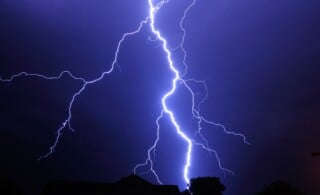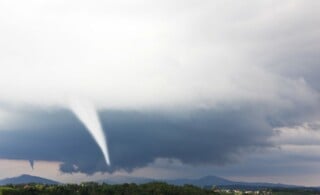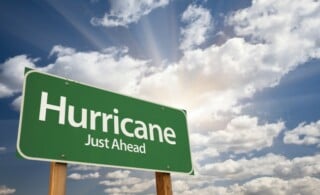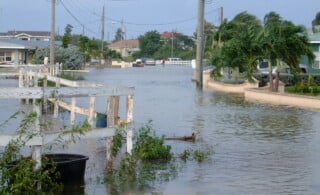
Natural disasters are nerve-wracking and unpredictable. Whether it’s a California earthquake, a Gulf Coast hurricane, an Oklahoma tornado or an ice storm in Texas, disasters add up to millions of dollars of losses each year.
Preparing for natural disasters before they strike will ensure that you and your home are safer. The good news is that there are many minor home improvements you can make to protect yourself. Read on to learn about common disasters in each region and how to prepare.
Table of Contents
- Wind Damage Prevention
- Earthquake Damage Prevention
- Landslide Damage Prevention
- Water Damage Prevention
- Fire Damage Prevention
- Snow and Ice Damage Prevention
- Creating a Disaster Plan and a Printable Template

Wind Damage
Severe weather such as tropical storms, tornadoes and hurricanes can all cause wind damage. If you live in areas prone to high winds, such as “Tornado Alley” and coastal regions predisposed to hurricanes, there are steps you can take to minimize potential damage. These include:
- Installing high-impact glass and storm shutters to protect your home from broken glass and flying debris.
- Adding a heavy-duty deadbolt lock and slide bolts that can reinforce double-entry doors and longer hinge attachments which can add strength and stability.
- Reinforcing garage doors with stronger wheel tracks and girts or sheeting rails that help resist wind load.
Another option is to build a safe room, which is a hardened structure designed to meet FEMA criteria for providing almost absolute protection in a severe wind event. You can install safe rooms in existing structures. FEMA created a comprehensive guide that outlines what’s needed for rooms to be hurricane and tornado-safe.
You can prepare for tornadoes and hurricanes in similar ways.
Tornadoes
From 1991 to 2010, the United States experienced an average of 1,253 tornadoes a year, with every state affected except for Alaska and Rhode Island.
Where Is Tornado Alley?
Tornado Alley is a region in the central United States and southern Plains where tornadoes are particularly common. The heart of this area stretches south from eastern South Dakota through most of Nebraska, Kansas and Oklahoma (plus the easternmost part of Colorado) down through northern Texas. Adjacent states to the east—Minnesota, Iowa, Illinois, Missouri and Arkansas—also experience significant numbers of tornadoes each year.
When buying a home in Tornado Alley, look for homes with concrete exteriors built into the earth, either wholly or in part. Domed structures are also a plus because their aerodynamic design can deflect high winds.
Hurricanes
Hurricanes pose an increasing threat. Four of the 10 most expensive hurricanes ever recorded occurred in 2017 and 2018. The danger is especially acute because of the high population in many coastal areas vulnerable to hurricanes, including cities such as New Orleans, Houston, Miami, and Mobile, AL.
High winds and flying debris associated with hurricanes can shatter windows, send trees crashing into homes, lift roofs, rip away siding and more. High surf and storm surges can create massive flooding near the coast and cause damage from flooding (ruined carpets, stained walls, destroyed belongings, etc.).
Where Are Hurricanes Most Likely to Occur?
In the United States, hurricanes are most likely to occur from August through October. They hit the southwestern gulf from Texas, across the Gulf Coast to Florida and all the way up the Eastern Seaboard to Maine. The 2020 Atlantic hurricane season broke a record for the number of named storms with 30, surpassing the record set in 2005.

How to Protect the Outside of Your Home From Wind Damage
- Fortify your roof: Add wooden braces to your rafters, use roofing cement on the edges of shingles and add metal hurricane clips.
- Maintain trees on your property: Trim trees and remove dead limbs that could break off and become dangerous projectiles.
- Install storm shutters: Hurricane shutters or plywood can protect you from flying glass and debris.
- Consider impact-resistant windows: Shatter-resistant glass comes in two types: One consists of two pieces of glass sandwiching a shatterproof inner membrane; the other, which is less effective, has a glaze applied to the surface. Heavy-duty framing makes windows more secure, too.
- Secure outdoor objects: Patio furniture, dog toys, children’s toys and recreational items such as ping pong tables should be stored safely inside.
- Seal and/or maintain seals in windows, cracks and gaps: You should do this in addition to adding hurricane shutters; simply taping cracks in windows by itself isn’t sufficient to safeguard against hurricane-force winds.
- Fasten manufactured homes to the ground: Make sure all tie-downs are sturdy.
- Secure any fencing, sheds or porches: Screw in ground anchors and strap down storage sheds. Consider chain-link fences because they don’t catch the wind; vinyl fences can also withstand strong winds if properly secured.
- Consider different landscaping materials: Use soft mulch instead of gravel, which could cause damage when blown by high winds.
- Anchor any fuel tanks or external utility links: Fuel and utility tanks can fly loose and become deadly airborne projectiles. Fuel tanks can also spill and help cause fires.
How to Protect the Inside of Your Home From Wind Damage
- Check your homeowners’ insurance: Know what it does and doesn’t cover. Do you need flood insurance?
- Make a list of your home’s contents: Catalog your valuables and estimate their value. Store any small, high-value items in a safe and keep the key with you at all times.
- Prevent power surges: When you get power back after a hurricane, it can cause power surges that can damage electronic equipment. Install surge protectors (not the same as simple power strips) to prevent this.
- Have a designated safe room: FEMA has a Q&A with all you need to know about safe rooms.
- Reinforce garage and double-entry doors: Garage door bracing can help secure your home during a hurricane; so can deadbolts and longer, more secure hinges on double doors.
Earthquake Damage
Earthquakes are strongest close to the fault line where they originated. If you want to know whether your home may be on a fault line, the USGS has an interactive fault map that you can use to zoom in on your particular location. It also has a map that shows where the most recent quakes have occurred. Check to see whether you’re in an at-risk area, then take steps to maximize your earthquake preparedness.
Where Do Most Earthquakes Occur?
In the United States, earthquakes are by far the most common and most dangerous in the West, specifically in the Pacific Coast region. That’s because this is where two large tectonic plates, the Pacific Plate and the North American Plate, converge.
The states that are considered most “seismically active” are Alaska and California. Rounding out the top five are Nevada, Hawaii, and Washington. The next five are in the West, as well: Wyoming, Idaho, Montana, Utah and Oregon.

How to Protect Your Home From Earthquakes
- Anchor large or top-heavy objects: Secure objects such as bookcases, grandfather clocks, and wardrobes to the wall (preferably to studs) whenever possible to keep them from falling in an earthquake.
- Secure fixtures and electronics in the home: Provide secure anchoring for smaller items such as picture frames and anchor televisions and other electronic devices to walls whenever possible, instead of just standing them on a piece of furniture.
- Avoid storing heavy objects on high shelves: Shelves that are already top-heavy are more likely to fall in the best of conditions. For example, when stocking bookcases, put the heaviest books on the bottom shelf and stock each successively higher shelf with lighter volumes.
- Secure water heaters: Fashion these to walls with straps so they can’t tip over, causing potential flooding or fire.
- Store flammable and toxic substances: Make sure any flammable materials are kept in a secure location and stored safely.
- Brace all suspended ceilings: These are usually composed of tiles suspended by a grid system and used to hide pipes, ductwork or wiring from view.
- Install cabinet latches: Don’t settle for simple handles that allow cabinets to fly open and dishes or other items to tumble out; install latches that can keep them closed in a tremor.
Landslide Damage
Landslides result in 25 to 50 deaths every year in the United States and cause more than $1 billion worth of damage. Several factors can trigger them, including soil that has become overly saturated after heavy rains or snowmelt. This is especially common on steep slopes such as the Pacific Coast between San Simeon and Big Sur.
Earthquakes can also trigger landslides. Steep slopes and loose, excessively heavy or saturated deposits are all known contributing factors. When tons of rock and soil come sliding down a hill or mountainside, they can prove damaging to whatever stands in their way. Minor slides can inundate homes, and major ones can carry entire structures away with them down a mountain.
Where Are Landslides Most Likely to Occur?
Landslides are most likely to occur in mountainous areas, but they happen in every state. Areas particularly prone to slides include the Pacific Coastal Ranges, Rocky Mountains, the Appalachian Mountains and some areas of Alaska and Hawaii.
How to Protect Your Home From Landslides
- Get a ground assessment of your property: Consult local officials to determine if any landslides have occurred in the past. Then, enlist a qualified professional to assess your property.
- Identify hazard zones and note areas of stormwater convergence: Watch for smaller slides and land movement or leaning trees to identify problem areas where runoff may be converging. Are fences leaning? Are external stairs pulling away from the building? Are you seeing cracks in plaster, tile or brick? These are some of the signs of a runoff issue.
- Install flexible pipe fittings: These help prevent gas and water leaks.
- Plant ground cover and build retaining walls: A retaining wall won’t stop a massive landslide, but it can stabilize the earth on smaller slopes and prevent minor soil movement from occurring. Ground cover can also work to minimize landslide damage. Consult a local landscape design specialist to find out what kinds of ground cover work best.
- Build walls to divert debris flow in mudflow areas: Direct the flow of floodwaters away from buildings using channels, piping or walls, but be sure you’re not sending it onto a neighbor’s property.
Water Damage
Tsunamis and flooding are two types of natural disasters that can cause significant water damage to your home, but there are numerous ways to prepare for them.
Tsunamis
Tsunamis are a rare event, and tsunamis that cause damage or deaths occur twice a year on average globally. If they happen in the United States, they’re most likely to happen on the West Coast. Tsunamis can cause flood damage to homes and their contents, but mostly in those built within several hundred feet of a coastline. Despite disaster-movie depictions, most tsunamis aren’t mammoth tidal waves but are actually less than 10 feet high.
Where Are Tsunamis Most Likely to Occur?
Tsunamis are most likely to happen near subduction zones where major earthquakes occur. The rise is highest in Alaska, Hawaii and the West Coast of the continental United States.
Flooding
Flooding is one of the most frequent and costly natural disasters in the United States, and it can occur in conjunction with other events such as heavy rains, hurricanes and landslides. In fact, 90% of natural disasters involve flooding. There are three types of flooding: river, coastal and flash floods.
Flooding causes severe water damage that leaves residents facing significant restoration projects and potential displacement from their homes. When purchasing a home, consider some aspects related to flooding, including whether it’s on a flood plain, whether there have been recent floods in the area and how often major floods occur.
Where Is Flooding Most Likely to Occur?
The low-lying Gulf Coast state of Louisiana is the state with the highest flood risk, followed by three other Gulf states: Florida, Mississippi and Arkansas. New Jersey, South Carolina, Maryland, Delaware, the District of Columbia and North Carolina round out the top 10. As you can see, these states are all within the hurricane arc on the Gulf and Atlantic coasts mentioned above.
However, homeowners in high-risk areas aren’t the only ones who need to be careful. Residents of low- to moderate-risk areas file 25% of all flood insurance claims.

How to Protect the Inside of Your Home From Floods
- Keep important documents and possessions in waterproof containers: Include things like your birth certificate, insurance documents, passports, tax documents, medical records, etc. Store them up high, above any potential flood level.
- Seal foundation and basement walls: Use hydraulic cement, caulk and mortar to seal any cracks.
- Install flood vents: These small openings can let water flow freely through a garage or crawl space, keeping water pressure from building up and causing walls to collapse.
- Install a sump pump: Sump pumps draw water away from your home and funnel it away from the foundation via drainage pipes. Be sure you have a good home generator to keep the power running.
- Prevent sewer backups: Consider one-way backflow valves for pipes that enter your home to keep floodwater from backing up into your house, and install drain plugs in basement floor drains.
- Use flood-resistant building materials: Wood isn’t the best option for floorboards or doors, and carpets can easily get ruined. Consider metal window frames and flooring materials such as ceramic tile or vinyl.
- Increase the height of electric service panels: Electrical outlets are often installed near floor level. Moving them up 1 foot above flood level can keep problems from occurring in your electrical system. Move any wiring and switches up, too, but make sure a licensed electrician does the work.
- Protect utilities and service equipment: Raise appliances above floor level, and move HVAC units to a higher floor.
- Anchor any indoor fuel tanks: Use a concrete slab as an anchor to keep them from being swept away by floodwaters.
- Consider installing a flood alert system: Flood sensors and early warning devices are available to keep you alert to any danger so you can take action if flooding is imminent.
How to Protect the Outside of Your Home From Floods
- Maintain proper water runoff and drainage: Make sure gutters, downspouts, etc., are kept clear of debris with frequent inspection and cleaning to ensure water flows away from your home without impediment.
- Identify and fix trouble spots in lot grading: Change your landscaping to improve runoff if necessary, channeling water away from your home and eliminating areas where water accumulates.
- Create more green space around the home: Options such as permeable pavements, rain gardens and vegetated swales can allow more rainwater to be absorbed into the ground, reducing the threat of water accumulation above ground and flooding.
- Consider installing a rain barrel: This is a particularly attractive option in areas where water shortages are common, and conservation is encouraged. A rain barrel at the end of a downspout is a great way to collect water from your roof.
Fire Damage
When most people think about wildfires, they consider the damage done by the fire itself. However, smoke can travel for hundreds of miles away from where the blaze is burning and take a significant toll on air quality.
Ash and microscopic particles can make indoor air quality worse without proper ventilation and filtration. Smoke can enter a home through doors and windows, HVAC systems with fresh-air intake and small openings in walls and cracks around window sealings. If you’re in a fire-prone area, ensure you have air purifiers and fresh air filters.
Wildfires
In 2020, there were 58,950 wildland fires in the U.S., up from 50,477 the year before. In California alone, the eight largest wildfires in terms of acreage have all occurred since 2017.
Where Are Wildfires Most Likely to Occur?
California was the state with by far the most fires (10,431) and the most acreage lost to fire (4.09 million acres) in 2020. Just to the north, Oregon ranked second in terms of total acreage at 1.14 million, followed by Washington at 842,370 acres, completing a Pacific Coast trifecta. In terms of the number of fires, Texas ranked second with 6,713.
As temperatures continue to rise and drought conditions emerge, other areas will also be at risk for more wildfires, and wildfire safety will be a growing concern.

How to Protect Your Home From Wildfires
- Assess your wildfire risk: Check the history of your property and the area at large to see whether wildfires are common. Is there a lot of overgrown vegetation in your area? What are fire insurance rates?
- Maintain plants and vegetation around the property: Don’t let vegetation go dry; keep it lush and watered. Use plants that don’t require much maintenance and won’t easily catch fire.
- Create a 30-foot safety zone around the house: Clear away dry brush and any other combustible materials; use gravel, concrete and brick in this area instead.
- Make a second zone 100 feet around the house: Create more spacing between plants in this area.
- Keep flammable materials away from the house: Don’t store combustible materials under your deck or near your home.
- Enclose decks and porches: The fewer entry points for potential sparks and burning ash, the better.
- Enclose eaves and overhangs: Keep these areas enclosed so dry material and brush can’t accumulate as readily, and monitor the area periodically.
- Consider non-combustible roofing materials: Fires often don’t strike adjacent buildings, but burning embers are carried by the wind and land on roofs away from the fire’s origin. Be ready for this by using fire-resistant roofing material such as asphalt shingles, slate or concrete and clay tiles.
- Cover chimneys and stovepipes with spark arrestors: Keep embers from entering your home with fine wire mesh.
- Consider fire-resistant siding: Options include brick, stone, stucco, metal and fiber cement. Avoid wood (although adding flame retardant can help) and vinyl.
- Consider special fire-resistant window treatments: Use fire-retardant fabric or blinds that have passed the NFPA 701 test.
Snow and Ice Damage
Blizzards are becoming more common in the continental United States. According to a recent study published in The American Meteorological Society’s journal, the number of blizzards per season has risen significantly over the past five decades. Therefore, concerns about snow and ice damage are something to take seriously.
Blizzards and Severe Winter Weather
Blizzards are most likely to happen in December and January, but since 1959, at least one has been recorded in every month except July, August and September. And there’s some chance they’ll happen almost everywhere except for the Deep South and a few pockets in the Southwest and Washington state.
Residents of some regions that aren’t used to extreme winter weather are finding themselves in need of snow shovels and thinking about winterizing their homes.
Where Are Blizzards Most Likely to Occur?
In the U.S., blizzards are most likely in the northern Great Plains states: the Dakotas (especially North Dakota), Minnesota, Nebraska and Colorado. Barnes, Benson, Cass and Traill counties in North Dakota have a 76% possibility of seeing a blizzard in any given year.

How to Protect Your Home From Blizzards and Winter Weather
- Protect your pipes from freezing: Let cold water run through pipes at a trickle on very cold nights. Add insulation to areas where pipes run through your home, and keep your thermostat set at a constant temperature night and day.
- Ensure heating systems are up to code: Check permit requirements.
- Check your home’s insulation: Add caulking and weatherstripping to windows, check your insulation’s R-value and upgrade it where necessary. Consider dual-pane windows if you don’t have them.
- Install window coverings or cover with plastic: Plastic inside your windows provides an extra layer of insulation against the cold.
- Consider purchasing flood insurance: This can cover any damage your home may incur during a spring thaw that can produce damaging floods.
Creating a Disaster Plan
With so many different disaster threats out there, you’re likely to be at risk for one or more, no matter where you live. That’s why it’s important to create a disaster plan specific to the types of natural disasters that may occur in your area.
You can check the CDC’s natural disaster resource page for recommendations on how to deal with everything from extreme heat to volcanoes.
Create an emergency preparedness checklist to ensure you don’t leave out anything essential. Among the things you should remember:
- Have a disaster kit for your family/yourself packed and ready in an easy-to-access location.
- Keep all essential documentation (passports; ID; wills and powers of attorney; insurance, tax, and medical records) in an easily accessible place to take with you.
- Designate a meeting plan and place for every member of your household.
- Know your local community resources and, if needed, evacuation routes.
- Consider keeping your vehicle packed with basics like a first aid kit, hand tools and area maps.
You never know when a disaster might strike, but you and your home can be prepared if one does.
Consult With a Disaster Recovery Pro Today

 Guide to Severe Thunderstorms
Guide to Severe Thunderstorms  5 Post-Tornado Safety Tips That Could Save Your Life
5 Post-Tornado Safety Tips That Could Save Your Life  Tornado Safety Guide
Tornado Safety Guide  Hurricanes for Kids – Safety Resources, Facts & Projects
Hurricanes for Kids – Safety Resources, Facts & Projects  5 Critical Post-Hurricane Safety Precautions
5 Critical Post-Hurricane Safety Precautions 

Are You Familiar With This Topic? Share Your Experience.